We may earn income from links in this post. Please read this Disclosure for details.
This mild, lightly-spiced chicken stew, known as pulique or pulique de pollo, is a delicious traditional Mayan dish typical in the highlands of Guatemala.
It’s a popular Guatemalan food eaten during holidays and ceremonies, special events and other large celebrations.
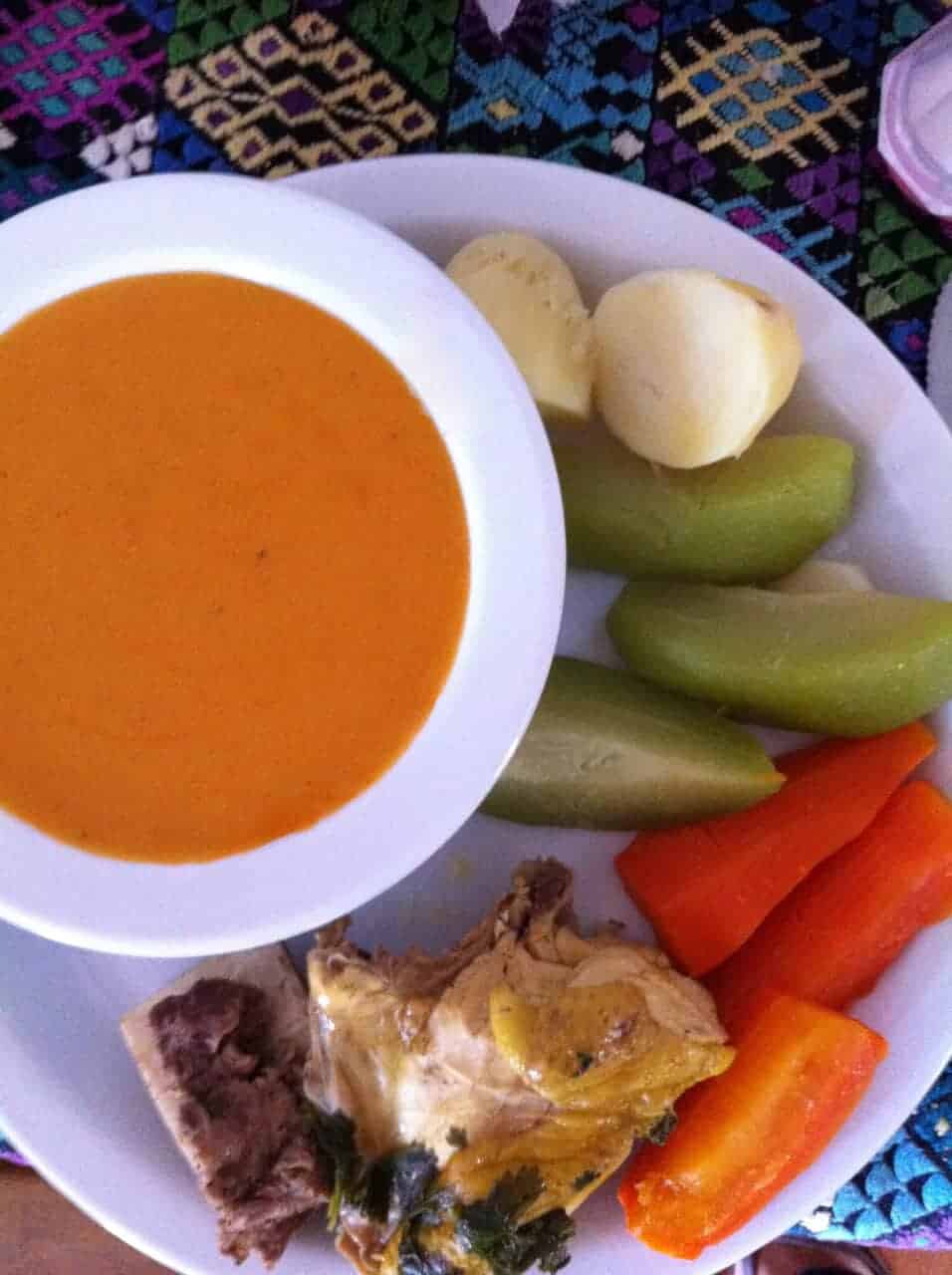
Pulique Ingredients
As far as grocery runs go, the trip from Panajachel to Sololá to buy ingredients for our pulique recipe is a stunner. With views of a cascading waterfall, Lake Atitlan and a 2-mile high volcano, it sure beat my usual trek to No Frills in Toronto.
It was 9:00 am and I was riding in a Blue Bird school bus aka Guatemalan “chicken bus” on a mission to scout out ingredients for pulique de pollo, a ceremonial dish popular among the Maya people in the midwestern highlands in Guatemala.
Unlike many other Mayan dishes such as kak’ik and pepián de pollo that require the charring of vegetables and chiles prior to cooking, the veggies for pulique are simply simmered.
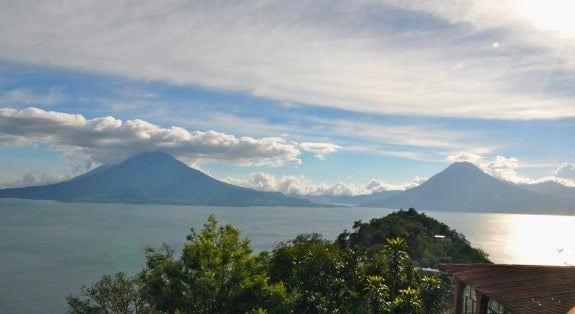
Olga, my Spanish teacher at Jardin de America Spanish School, who is Kaqchikel indigenous Maya, had offered to substitute a traditional Guatemalan food cooking class for our desk-bound studies.
So, all we had to do was get to the town of Sololá, a 20 minute bus ride into the mountains and buy the ingredients for our pulique recipe.
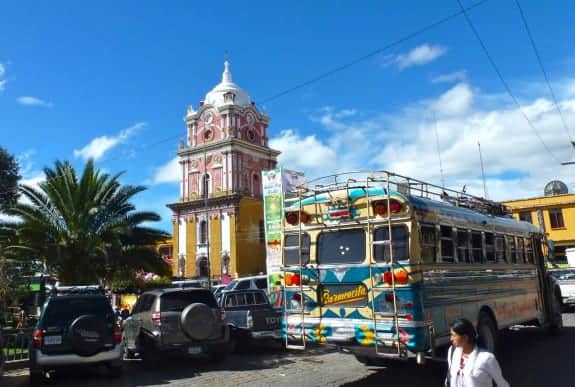
Upon arrival in Sololá, we hiked the six uphill blocks from the main square to the market. Market day is Mondays and Fridays so the streets were bursting with vendors and shoppers in traditional Guatemalan clothing.
Pick-up trucks were packed to the brim with boxes of produce as well as livestock and crates of chickens.
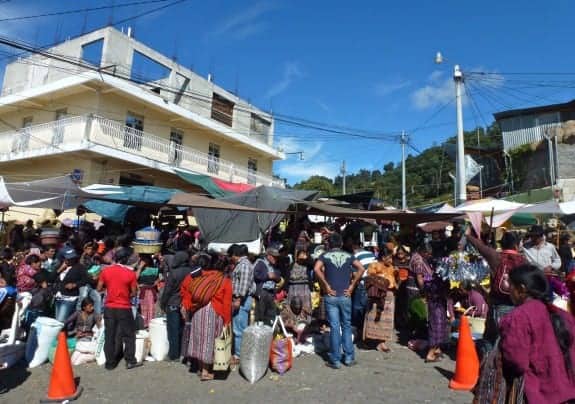
“Follow me” said Olga, as she disappeared in the crowd and then materialized magically in front of a stack of tomatoes. I dodged a vendor who was balancing 15 cartons of eggs on her head.
But my hesitation earned me a giant-sized push from a tiny woman who looked like Grandma Moses but whose biceps rivalled Vin Diesel’s in strength.
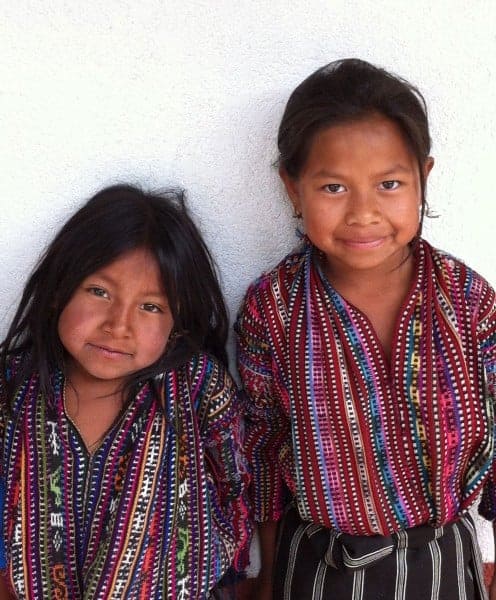
The market was a whirlwind of colour, people and new ingredients. From maxan leaves large enough to use as yoga mats to blue crabs skewered live on thin reeds, there was plenty to gawk at.
If you weren’t sure what to buy, you could just drift on the momentum of the crowd until you arrived at a food stall that looked promising.
For our pulique de pollo we stocked up on criollo ( yellow skinned) chicken which is more expensive than white chicken ( 12 Q vs 8 Q a pound) but more flavourful.
With the rest of the ingredients for our pulique recipe in hand — beef, cilantro, huisquil ( also known as chayote) and masa flour — we headed back to the bus.
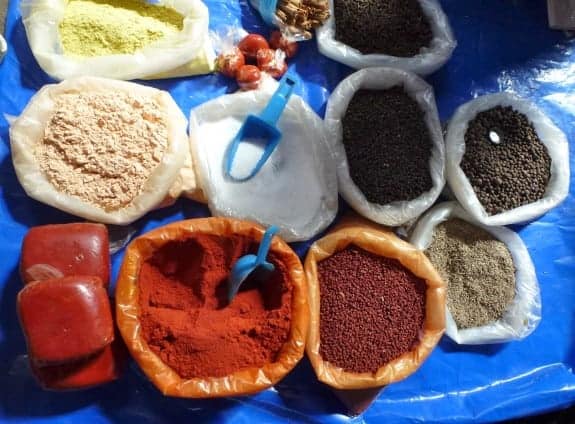
Back in my mini-apartment kitchen in Panajachel (read more about it in this Guide to One Month in Panajachel) we got to work. My job was peeling the vegetables–carrots the size of rolling pins, potatoes and huisquil, a vegetable pear also known as chayote.
We’d chosen the prickly huisquil (for better flavour) so my job wasn’t as easy as it sounds. After disinfecting the cilantro, green onions and hierba buena with Microdyne solution, Olga began cooking.
“If you’re making pulique for 50 people, it’s traditionally done outdoors over an open fire with a huge paddle,” she explained. “Your arms are usually sore and singed with fire by the time you’re finished.”
Fortunately, there was just the two of us so no burnt arms were needed and the sauce thickened up nicely.
She served it in a bowl with the vegetables and meat on the side.
I lifted a spoonful into my mouth and was surprised to discover it was mild but packed with the flavours of fresh-picked market vegetables and accented by the nutty taste of maize corn. I love spicy food so I crushed chiltepe hot peppers over top.
Delicious!
Guatemalan Pulique Recipe – Pulique Guatemalteco
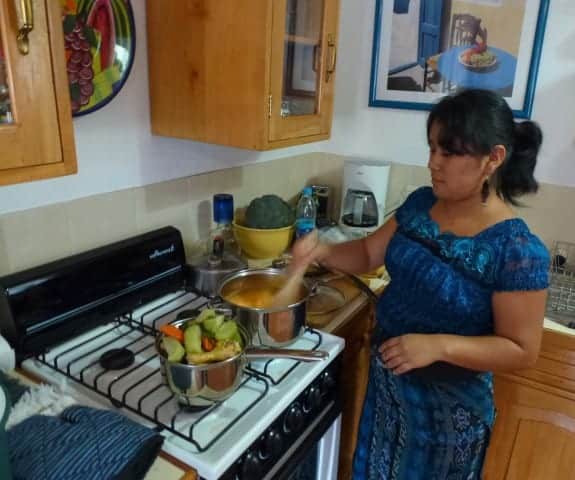
1. Simmer the beef bones (in water to cover) with 3 leaves of hierba buena ( substitute mint if needed), cilantro and a green onion for one hour.
2. Simmer chicken (in enough water to cover) with 3 leaves of hierba buena, cilantro and a green onion for 30 minutes. Remove chicken and reserve.
3. Add the chicken to the broth and simmer until tender but not mushy.
4. Strain the beef and vegetables, reserving the liquid.
5. Mix the dry masa with enough water so you can form six small balls out of it.
6. Liquify the achiote with 3 tomatoes, 3 balls of masa and the liquid from the beef and chicken. Add more balls of masa dough if it looks watery.
7. Strain the tomato masa mixture into another pot on the stove.
8. Stir with a wooden spoon over medium low temperature until thick and creamy.
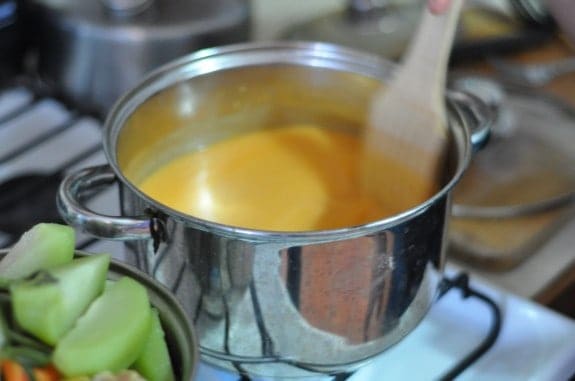
Tips for Making Pulique
- You’ll need several large pots to make pulique as the meats need to be cooked separately to create the broth.
- The key to making traditional pulique de pollo is to create a smooth and creamy sauce. This means you need to be vigilant when stirring to be sure not to burn it while it thickens.
- Avoid lumps by making balls out of the masa and adding them one at a time.
- Olga served the pulique with the meat, sauce and vegetables separated on the plate. It’s also traditional in Guatemala to serve pulique mixed together in one pot. So you can certainly add the meat and vegetables to the sauce when serving.
- This recipe can be doubled and tripled to serve a crowd. It’s a traditional Guatemalan food enjoyed throughout the country on special occasions and during Guatemalan holidays.
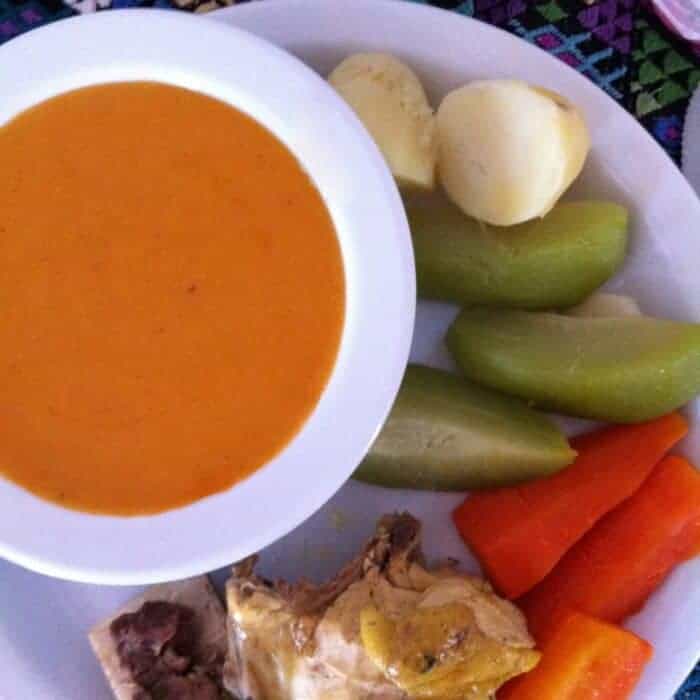
If you have leftover Masa Harina, use it up in our recipe for Easy Gluten-free Plum Cobbler or in Champurradas, a traditional Guatemalan cookie.
Pulique de Pollo: Guatemalan Stewed Chicken
Ingredients
- 1 pound beef bones optional
- 1 pound chicken organic or yellow skin
- 4 potatoes peeled and halved
- 1 1/2 huisquil rinse to remove stickiness
- 2 cups masa corn flour wet
- 6 small tomatoes
- 1/ 2 teaspoon achiote paste
- One bunch each of fresh cilantro, hierba buena (fresh mint) and green onion
Instructions
- Simmer the beef bones (in water to cover) with 3 leaves of hierba buena, cilantro and a green onion for one hour;
- Simmer chicken (in enough water to cover) with 3 leaves of hierba buena, cilantro and a green onion for 30 minutes. Remove chicken and reserve;
- Add the vegetables to the chicken broth and simmer until tender but not mushy;
- Strain the beef and vegetables reserving the liquid;
- Shape the masa into 6 small balls of dough;
- Liquify the achiote with 3 tomatoes, 3 balls of masa and the liquid from the beef and chicken. Add more balls of masa if it looks watery;
- Strain the tomato mixture into a pot on the stove;
- Simmer, stirring continuously for 15 minutes. Add more liquid if it gets too thick.
- The key to success for pulique de pollo is in the stirring. According to Olga, it's important to simmer the sauce until it's the colour of a mandarin orange. She was vigilant in this task, not removing the spoon from the pot for even a minute.
Notes
- The key to success for pulique de pollo is in the stirring. According to Olga, it's important to simmer the sauce until it's the colour of a mandarin orange. She was vigilant in this task, not removing the spoon from the pot for even a minute.
Nutrition
Travel Planner for Pulique Recipe and Cooking Class for Pulique de Pollo
Jardin de America Spanish School: To enroll in 4 hours of classes per day with one student and one teacher, the cost of lessons is $110 USD a week (subject to change). If you’re planning to study for longer than a week, you can ask for a discount like I did.
Excursions to market towns, cultural activities or dancing lessons are free but you’ll need to pay your own bus fare and costs for entrance fees or materials if applicable. Jardin de America Spanish School
Bus from Panajachel to Solola: Fare is 3Q each way. Tip: Sit near the back so you can get off the bus faster.
Where to catch the chicken bus: In Panajachel, catch the bus to Solola on Calle Principal between Avenida Santander and Calle del Embarcadero. The bus will be parked on the north side of the street. Check with the driver to be sure of the destination before boarding. In Solola, catch the bus to Panajachel between the church and Central Park.
You Might Also Like These Authentic Guatemalan Recipes:
- Guatemalan Black Bean Soup – Sopa de Frijol
- Jocon – Chicken with Tomatillo Sauce
- Salpicon de Res Recipe from Guatemala
- Tortitas de Ejote (Green Bean Fritters) Recipe from Guatemala
- Bacalao a la Vizcaina ( Salt Cod) from Guatemala
- Creamy Avocado Salad Dressing Recipe

Dividing her time between Canada, Guatemala and Mexico (or the nearest tropical beach), Michele Peterson is the founder of A Taste for Travel. Her award-winning travel and food writing has appeared in Lonely Planet’s cookbook Mexico: From the Source, National Geographic Traveler, Fodor’s and 100+ other publications.
Read more about Michele Peterson.

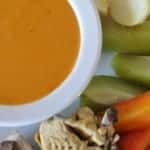
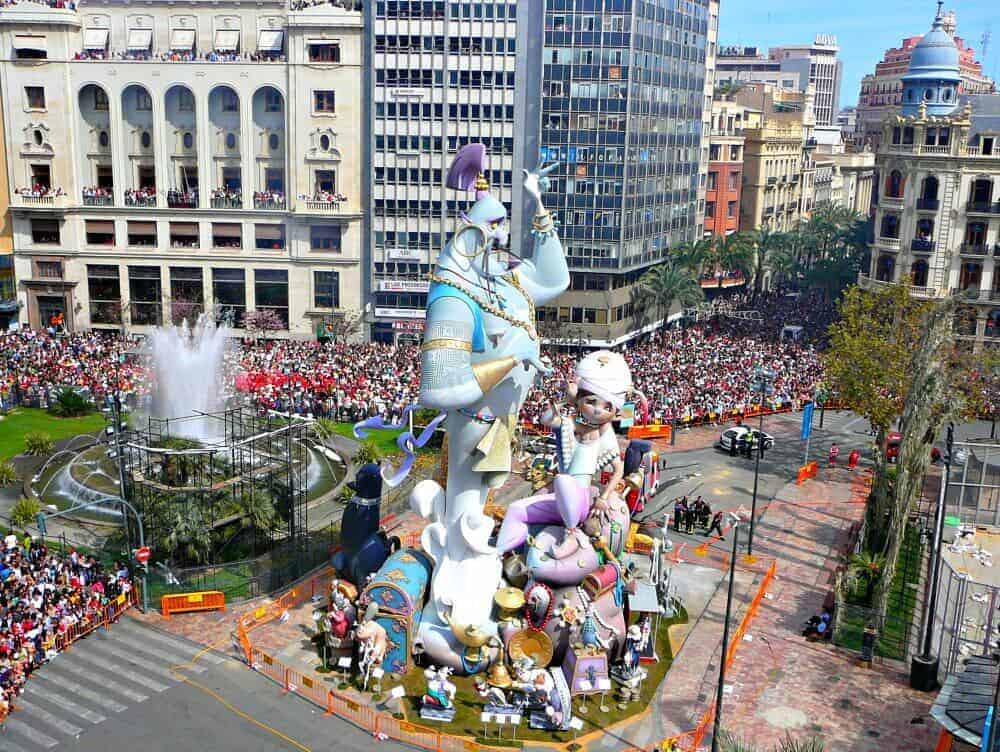 A Guide to Fireworks and Food at Las Fallas Festival in Valencia
A Guide to Fireworks and Food at Las Fallas Festival in Valencia
Alma Munozl
Michelle, love ur receipe!!! I am guatemalan, left my beautiful country when I was 18, but have gone back every time I get a chance. I wrote almost all of my mom’s recipes before her passing in 2010 , but somehow we did not write the pulique one, which is one of my favorites. Thanks for completing my little receipe book. It was refreshing to see again all the natural beauty of Solola y Panajachel . keep enjoying your travels and please continue to share ur great receipes.
Michele Peterson
Hi Alma…thanks so much for your kind comments. I’m so sorry to hear of your Mom’s passing…what a treasure to have her recipes preserved as a legacy. You must have some wonderful memories of the meals you enjoyed. Please let me know if you make the pulique recipe. I’d love to hear how it goes!
Mike (Nomadic Texan)
Michele,
I loved this post. I try to take cooking classes in every country I visit. It is always fascinating to see how various cultures prepare their food and what different spices and ingredients they rely on. I had two classes last fall in Ecuador and was enthralled with their techniques. Thank you for sharing the recipe so we can all experiment! Safe Travels.
Mike
Suzanne Fluhr
Pulique sounds like the perfect Central American dish for me because I don’t like/can’t eat spicy (picante) food. Your trip to the market reminds me of the markets in San Miguel de Allende when I lived there for a year as a child (9-10) with my family in 19630.
Neva @ Retire for the Fun of it
Your beautiful photos gave an in-depth view of living in the area. I would’ve loved to ride a local bus and hunt down ingredients with you. So fun.
Irene S. Levine
Sounds like your trip to Guatemala was such a rich experience in so many ways. Can’t wait to catch up and hear more about it.
Lesley Peterson
It’s incredible what you passed on a 20-minute bus ride! From yellow chicken to blue crabs, Guatemalan food sounds colorful as well as tasty.
Wandering Carol
I want to take the chicken bus and I want to know why yellow-skinned chickens are more expensive than white-skinned ones. Great post, Michele.
Katherine
Hello, my family is Guatemalan and we eat pulique often. It’s so delicious and healthy. I asked my sister, who grew up in Guatemala, why the yellow chicken is more expensive; she said because it’s hen! Hen in Guatemala is used in many dishes and tastes fantastic.
Michele Peterson
You’re right! Pulique is super healthy as unlike many other chicken dishes it’s not fried so that makes it low in fat. Yum!
Viv
Great post and excellent photos. Can’t wait to try making the recipes.
esperanza
Shopping for pollo and vegetables in Guatemala is sure a lot more exciting than hiking to the local supermarket and the result looks so delicious! What wonderful views of waterfalls and mountains along the way!!
Patti Morrow
Your photos really reminded me of how much I love Central America — the stunning scenery, the warm people, the delicious food…..
sarah
I miss Guatemala already having been back in Mexico for 10 days now. I loved the country, the people, the food…it really exceeded my expectations. I was so impressed with the markets, such quality and variety of produce made me regret not getting a place with a kitchen for a month or two so that I could learn to cook some of their delicious dishes. I’ll be following your posts somewhat enviously!
Michele Peterson
Yes, the markets in Guatemala are definitely a source of inspiration (and some puzzlement at least to me as there is always something new to discover). I’ll bet you had fun exploring all the exotic fruit even without a kitchen.
Nancy Thompson
What a wonderful adventure. There is truly no better way to learn the language or meet the most interesting people than to ride the local bus.
Doreen Pendgracs
Loved your post, Michele. It reminded me how beautiful the Guatemalan people are. And how colourful the country is! I am very sure that I ate pulique during our brief visit there, as your final pic looks highly familiar, but it was long ago. Time for a return visit!
Michele Peterson
Thanks Doreen! Yes it’s definitely time for you to make a return visit there’s a revitalization of quality cacao production and many new artisanal chocolate shops and producers to explore.
Marilyn Jones
I am so impressed with your narrative and your gorgeous photos. This is an excellent article. Thank you for sharing your adventure!
Michele Peterson
Thanks Marilyn…it was a fun day!